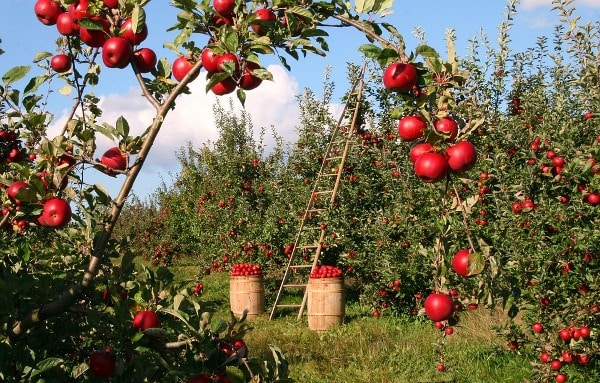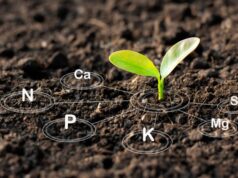Introduction:
Apple is a fruit that is widely grown across the world due to its economic importance, nutritional value, and versatility. Apples can be eaten raw, cooked, juiced, or dried. They are also used in the production of cider, vinegar, and other apple-based products. Apple plantation requires careful planning, preparation, and management to ensure optimal yields and quality. In this guide, we will discuss the various aspects of apple plantation, including site selection, soil preparation, planting, pest and disease management, pruning, harvesting, and storage.
Site Selection:
When selecting a site for apple plantation, it is essential to consider several factors. The first factor is soil drainage. Apple trees do not tolerate waterlogged soils and require well-drained soils to thrive. A site with good soil drainage allows water to drain away quickly and prevents root rot, a fungal disease that affects the roots of the trees. A site with poor drainage can be improved by digging a drainage ditch or installing drainage tiles to divert excess water away from the planting area.
The second factor to consider is sunlight exposure. Apple trees require at least six hours of direct sunlight daily to produce fruit. A site with insufficient sunlight can lead to poor fruit quality, low yields, and increased pest and disease pressure. The planting site should have an unobstructed view of the sun, and any shade-producing structures such as buildings or trees should be at least 50 feet away from the planting area.
The third factor to consider is soil pH. Apple trees prefer slightly acidic soils with a pH between 6.0 and 6.5. Soil pH can be determined by soil testing, which involves sending a soil sample to a laboratory for analysis. The test results provide information on the soil’s pH, nutrient levels, and other properties. If the soil is too acidic or alkaline, lime or sulfur can be added to adjust the pH.
Soil Preparation:
Soil preparation is a crucial step in apple plantation, as it affects the growth and productivity of the trees. The first step in soil preparation is to remove weeds, rocks, and debris from the planting site. Weeds compete with the trees for nutrients, water, and sunlight, and can harbor pests and diseases. Rocks and debris can interfere with root growth and soil aeration.
The second step in soil preparation is to till the soil to a depth of at least 12 inches. Tilling loosens the soil, promotes root growth, and improves soil aeration. A well-aerated soil allows roots to penetrate deep into the soil, where they can access water and nutrients more efficiently.
The third step in soil preparation is to add organic matter such as compost or manure to the soil. Organic matter improves soil fertility and structure, increases soil water-holding capacity, and enhances soil aeration. Organic matter can be added to the soil by spreading a layer of compost or manure over the planting site and tilling it into the soil.
Need apple seeds? Buy here
Planting:
Apple trees can be planted using several methods, including bare-root, container-grown, or balled and burlapped trees. Bare-root trees are dormant trees that have been dug up from the ground and stored without soil around the roots. Container-grown trees are trees that have been grown in a container and have a root ball that contains soil. Balled and burlapped trees are trees that have been dug up from the ground with the roots wrapped in burlap.
The first step in planting apple trees is to dig a planting hole that is twice as wide as the root system and deep enough to accommodate the root ball. The soil should be loosened and aerated at the bottom of the hole to allow for good root growth. The second step is to spread the roots of the tree out in the hole and backfill the soil around the roots, ensuring that the tree is planted at the same depth it was growing in the nursery.
The third step is to firm the soil around the tree to eliminate air pockets and promote good soil-to-root contact. The fourth step is to water the tree thoroughly to settle the soil and ensure good soil-to-root contact. Finally, a layer of mulch can be added around the tree to conserve moisture, suppress weeds, and regulate soil temperature.
Pest and Disease Management:
Apple trees are susceptible to various pests and diseases that can affect tree growth, fruit quality, and yield. Common apple pests include aphids, mites, caterpillars, and codling moth. Common diseases include apple scab, powdery mildew, and fire blight. To manage pests and diseases, a combination of cultural, mechanical, and chemical control methods can be used.
Cultural control methods include selecting disease-resistant varieties, maintaining proper tree spacing, and practicing good sanitation. Mechanical control methods include pruning infected plant parts, removing and destroying infected fruit, and using traps to catch pests such as codling moth. Chemical control methods include using insecticides and fungicides to control pests and diseases.
Pruning:
Pruning is a critical aspect of apple tree management as it promotes tree growth, fruit production, and disease prevention. Pruning involves removing dead, diseased, or damaged branches and shaping the tree to promote good light penetration, air circulation, and fruit quality. Pruning should be done during the dormant season, before bud break, to avoid damaging the tree and spreading disease.
Harvesting:
Apple trees typically begin producing fruit three to five years after planting, depending on the variety and growing conditions. Apples should be harvested when they are fully mature, but before they are overripe or damaged. Mature apples are firm, crisp, and flavorful, and their color should be uniform and bright.
Apples can be harvested by hand or with mechanical harvesters, depending on the size of the orchard. Hand harvesting is the preferred method for high-quality fruit as it reduces damage and bruising. Apples should be handled carefully during harvesting and transport to avoid dropping or throwing, which can cause bruises and reduce fruit quality.
Storage:
After harvesting, apples should be stored properly to maintain their quality and freshness. The ideal storage conditions for apples are cool, humid, and dark environments. The temperature should be between 30-40 degrees Fahrenheit, and the humidity should be around 90%. Apples should be stored in ventilated containers, such as crates or bins, to promote air circulation and prevent moisture buildup. They should be sorted and graded according to size, color, and quality before storage. Apples should also be checked regularly for signs of spoilage or disease, and any affected fruit should be removed immediately to prevent the spread of disease.
Need apple seeds? Buy here
Conclusion:
Apple plantation requires careful planning, preparation, and management to ensure optimal yields and quality. The site selection, soil preparation, planting, pest and disease management, pruning, harvesting, and storage are all critical aspects of apple plantation that should be given proper attention. By following the guidelines outlined in this guide, you can grow healthy and productive apple trees and produce high-quality apples for various uses. Whether you are a commercial grower or a backyard gardener, apple plantation can be a rewarding and profitable venture with the right knowledge and practices.








